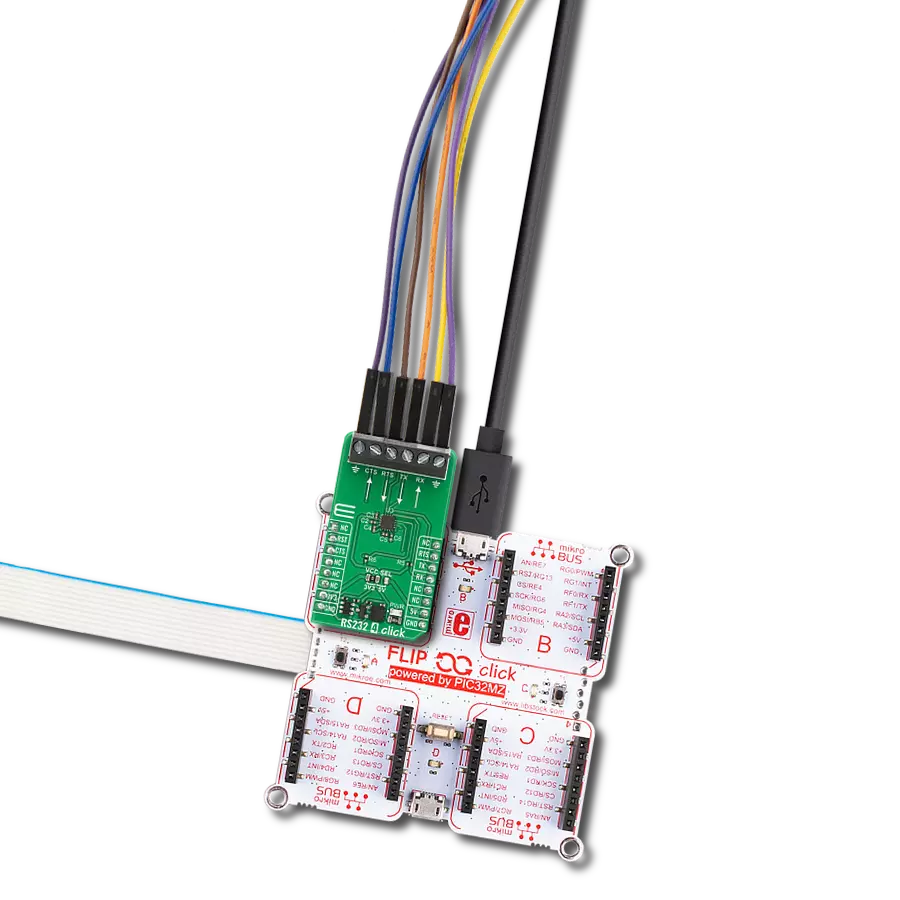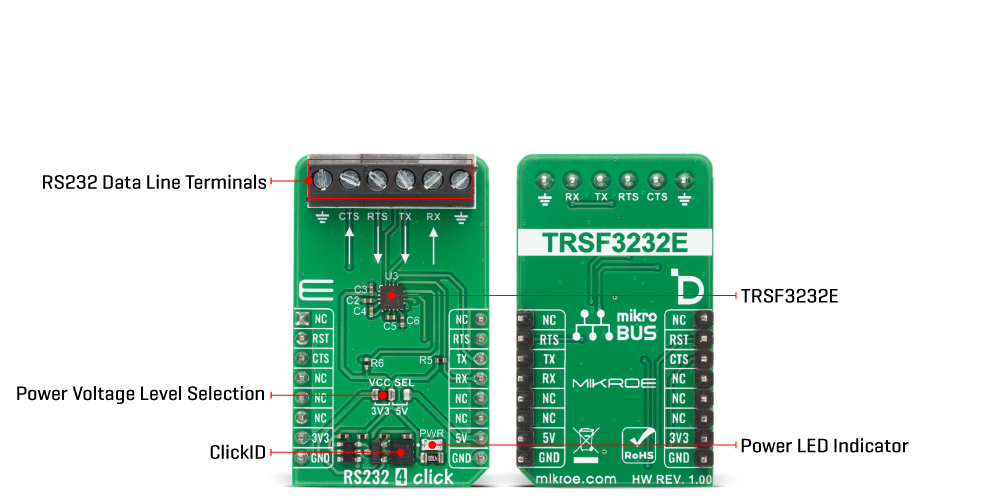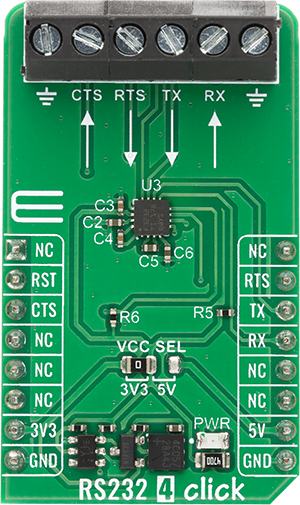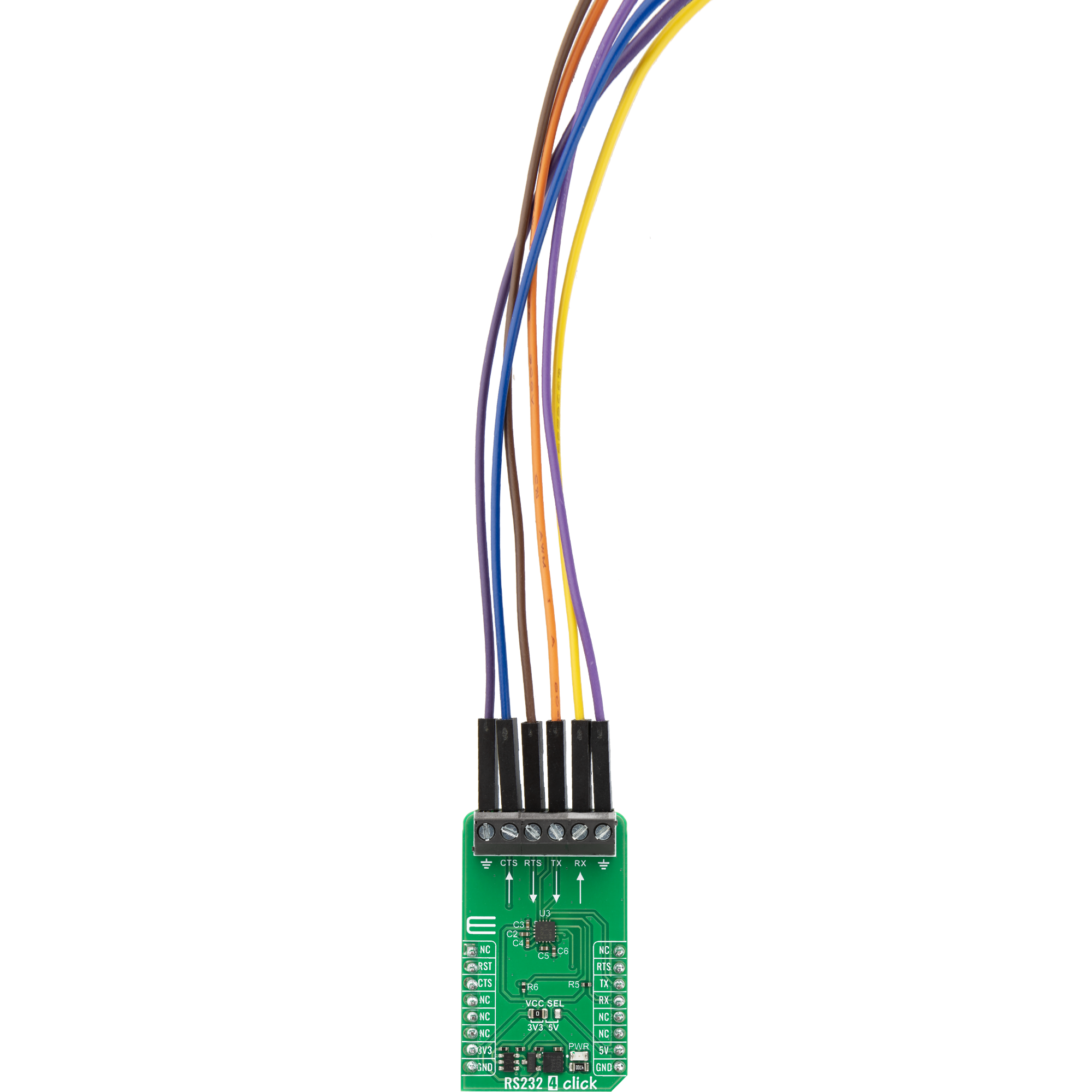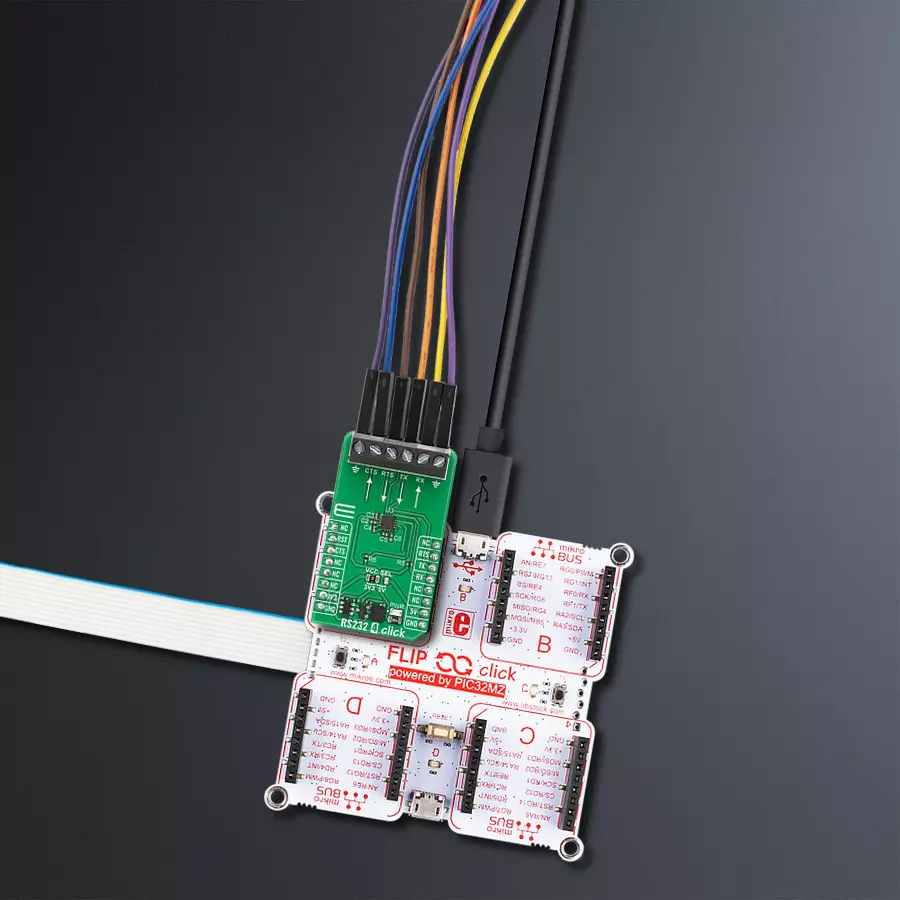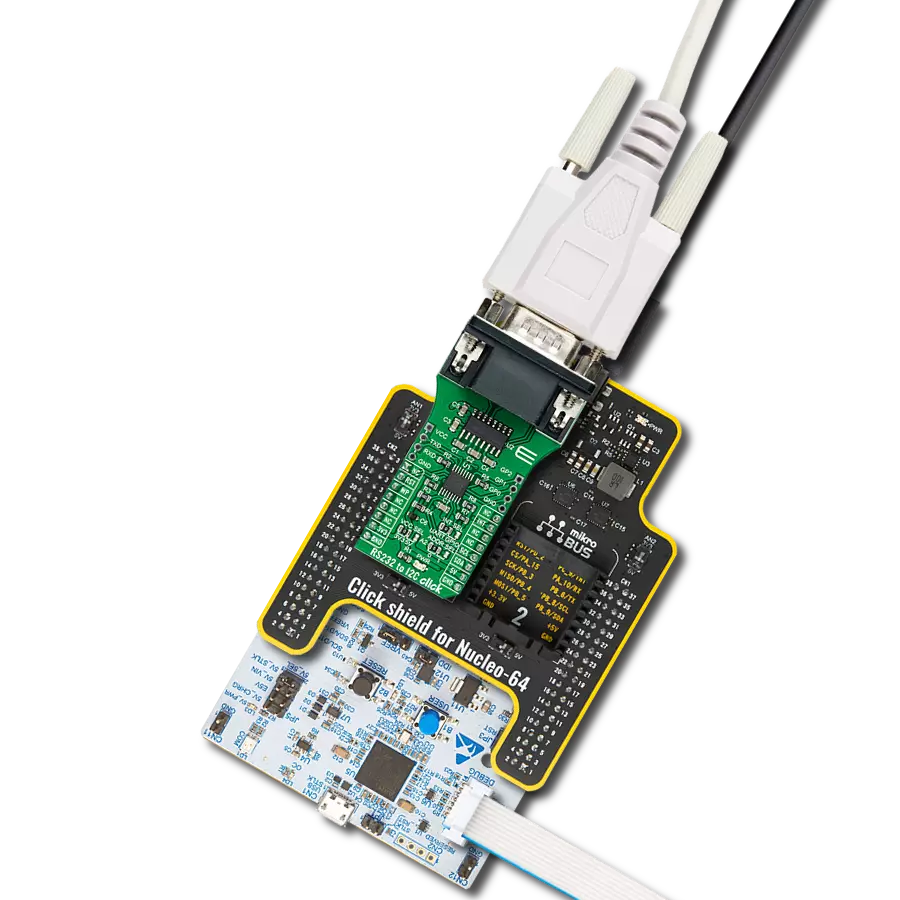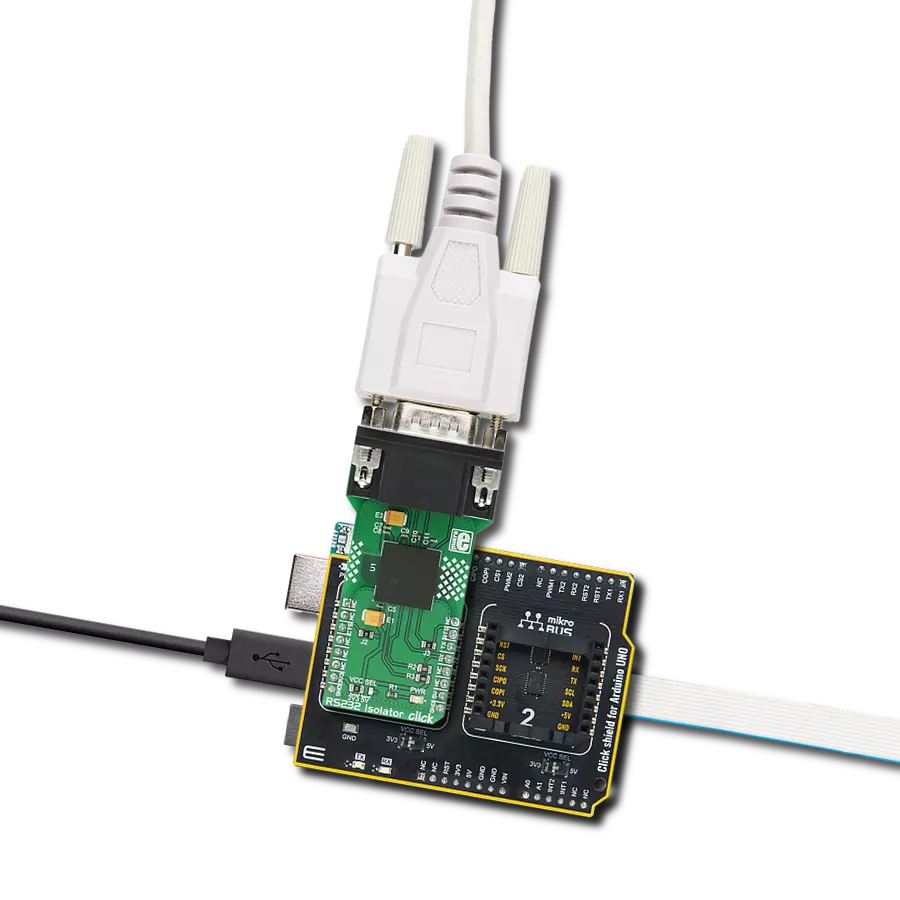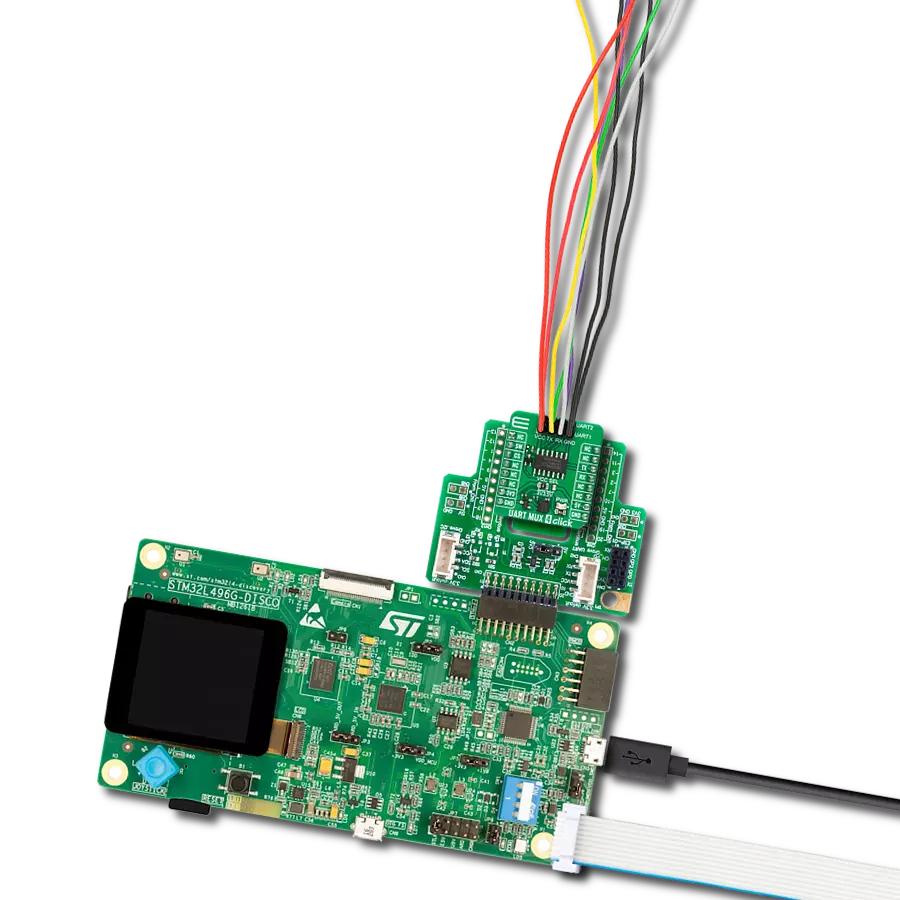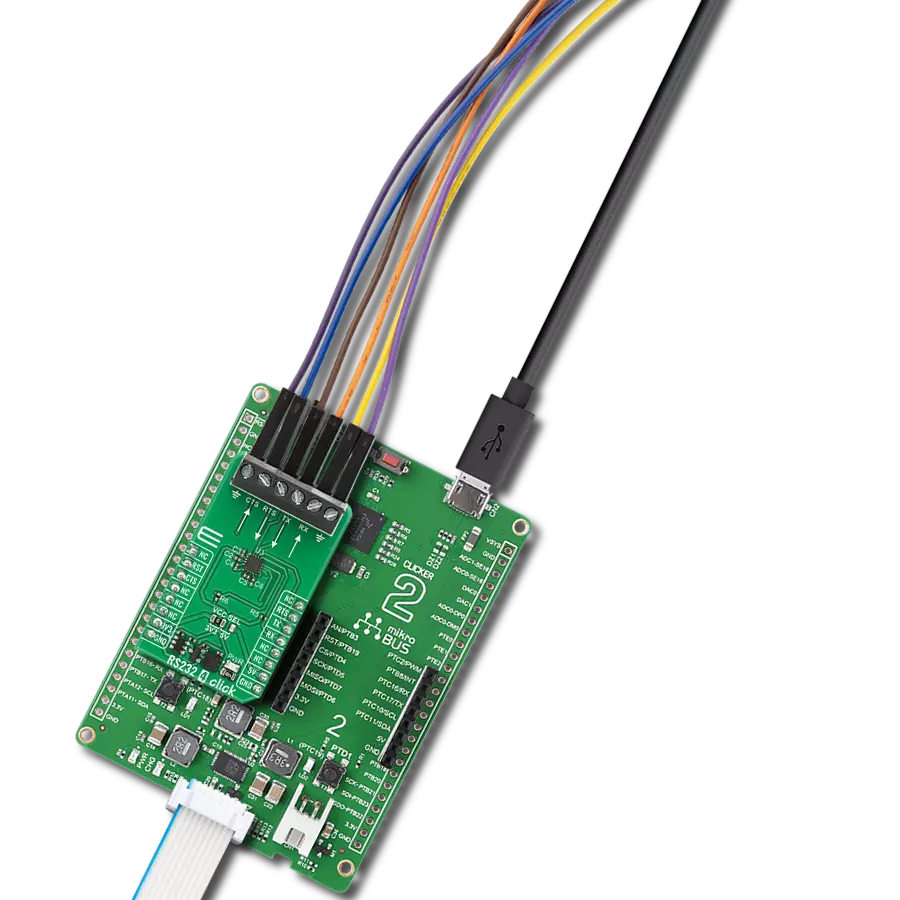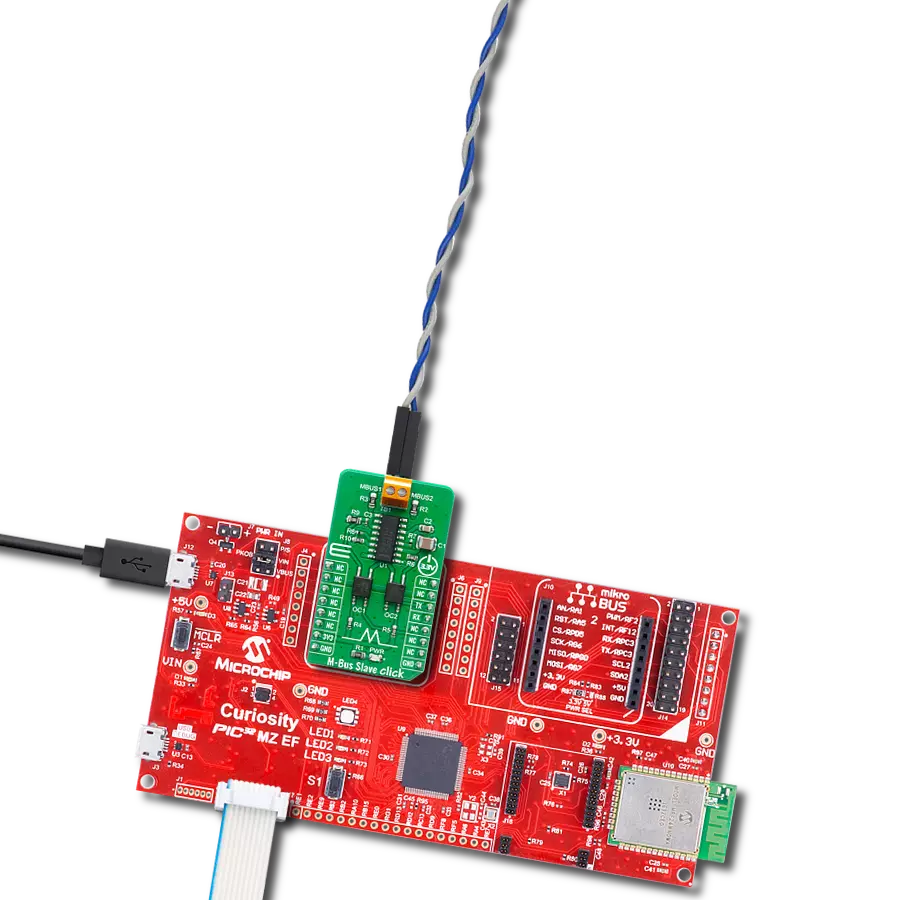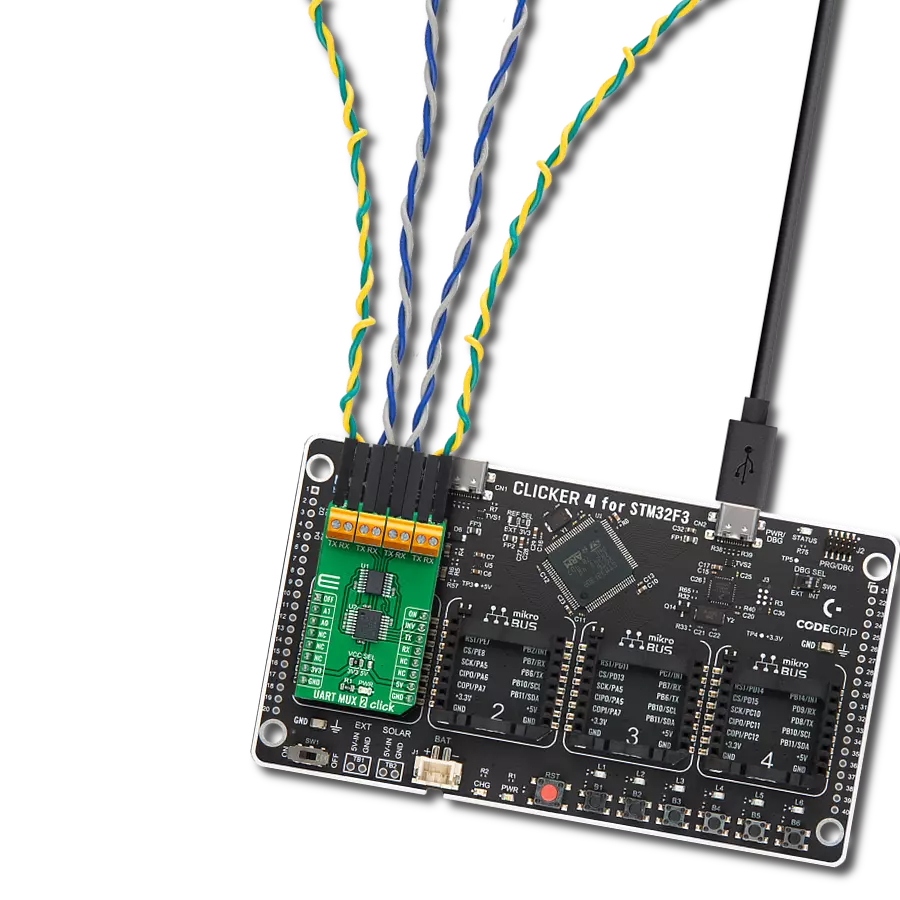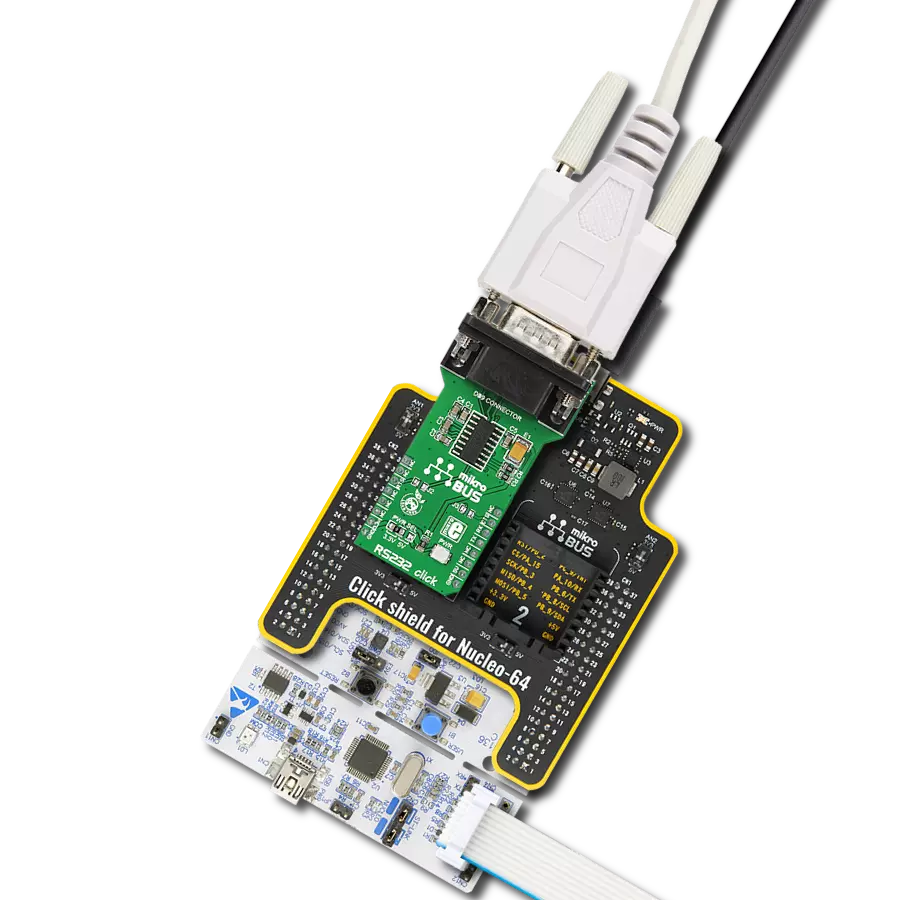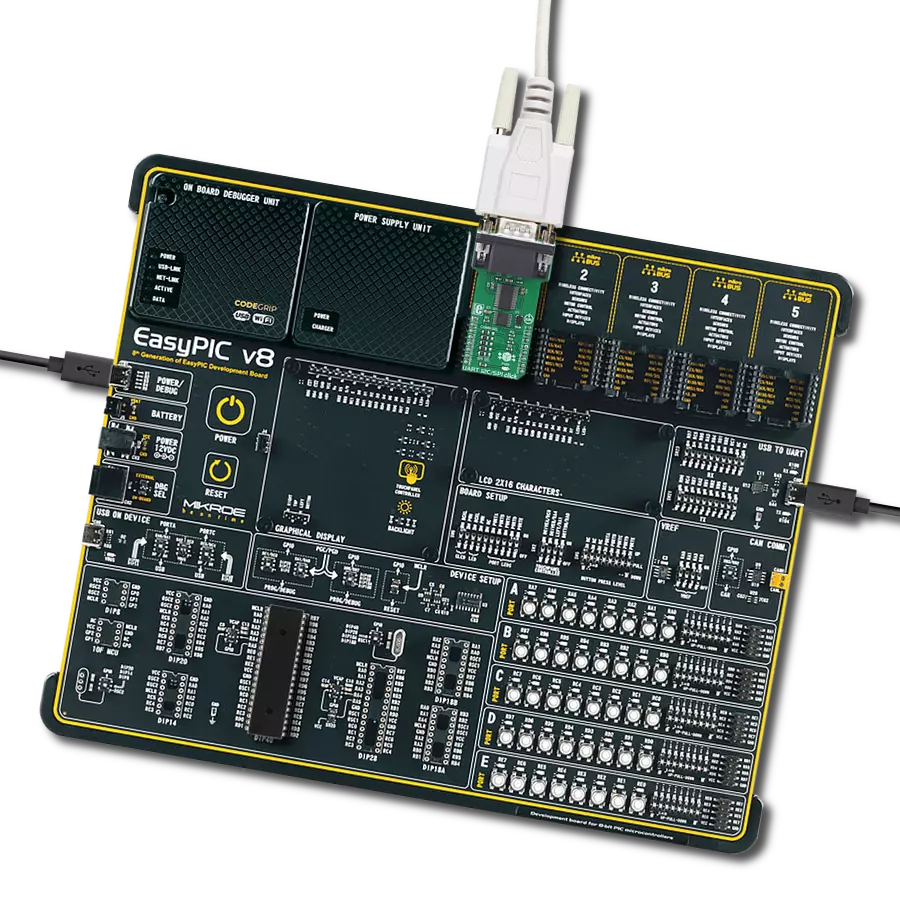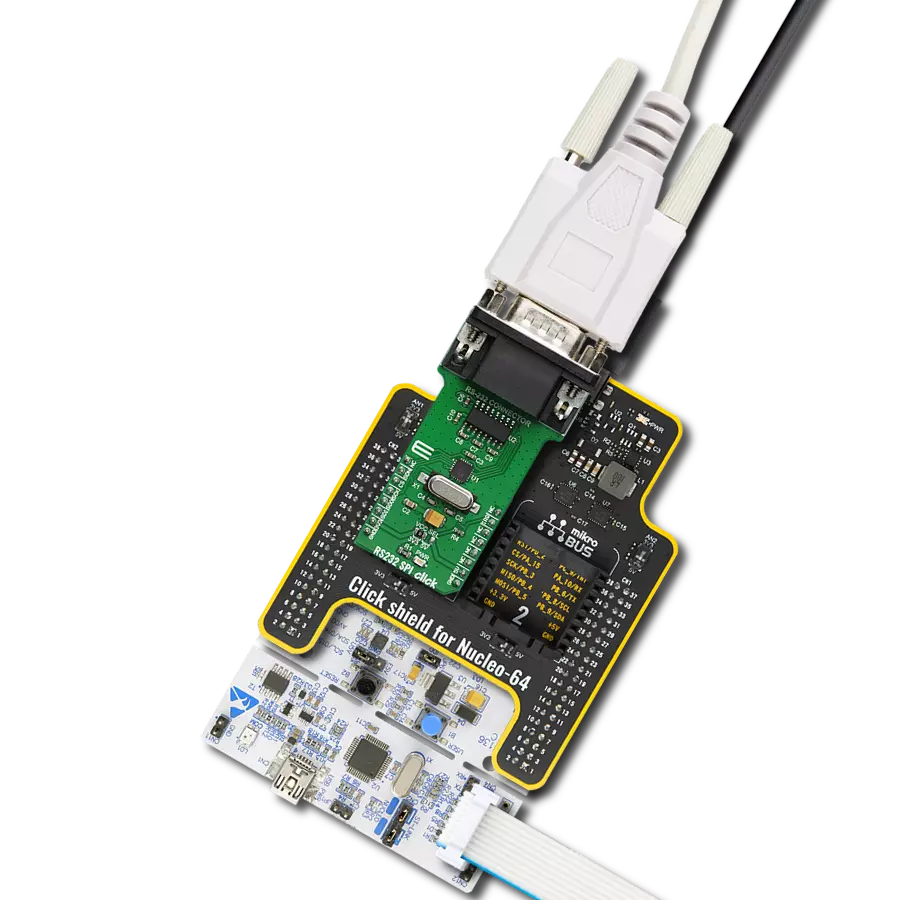Achieve fast and reliable RS232 data exchange with ±15kV ESD protection and 1Mbit/s signaling
A
A
Hardware Overview
How does it work?
RS232 4 Click is based on the TRSF3232E, a two-channel RS232 line driver and receiver from Texas Instruments, which integrates two line drivers, two line receivers, and a dual charge-pump circuit to generate the necessary RS232 voltage levels from a single supply. This Click board™ provides a reliable RS232 interface solution for asynchronous serial communication, designed to achieve robust data exchange between MCUs and external serial devices. With built-in ±15kV ESD protection on all serial-port connection pins, including ground, the device ensures high immunity to electrostatic discharges, making it suitable for use in demanding industrial and portable applications. This Click
board™ establishes communication between the TRSF3232E and the host MCU through a UART interface, using standard UART RX and TX pins and hardware flow control via CTS and RTS pins. The default communication speed is set at 115200bps, ensuring efficient data exchange. The TRSF3232E supports data signaling rates up to 1Mbit/s while maintaining a controlled driver output slew rate between 14V/μs and 150V/μs, enabling fast and reliable communication without excessive signal distortion. The RS232 4 Click offers integration into systems where legacy or long-distance serial communication is required. This makes it an ideal solution for a wide range of use
cases, including industrial PCs, wired networking, enterprise and data center equipment, battery-powered systems, handheld devices, PDAs, notebooks, and palmtop computers, where stable, high-speed, and protected RS232 communication is essential. This Click board™ can operate with either 3.3V or 5V logic voltage levels selected via the VCC SEL jumper. This way, both 3.3V and 5V capable MCUs can use the communication lines properly. Also, this Click board™ comes equipped with a library containing easy-to-use functions and an example code that can be used as a reference for further development.
Features overview
Development board
Flip&Click PIC32MZ is a compact development board designed as a complete solution that brings the flexibility of add-on Click boards™ to your favorite microcontroller, making it a perfect starter kit for implementing your ideas. It comes with an onboard 32-bit PIC32MZ microcontroller, the PIC32MZ2048EFH100 from Microchip, four mikroBUS™ sockets for Click board™ connectivity, two USB connectors, LED indicators, buttons, debugger/programmer connectors, and two headers compatible with Arduino-UNO pinout. Thanks to innovative manufacturing technology,
it allows you to build gadgets with unique functionalities and features quickly. Each part of the Flip&Click PIC32MZ development kit contains the components necessary for the most efficient operation of the same board. In addition, there is the possibility of choosing the Flip&Click PIC32MZ programming method, using the chipKIT bootloader (Arduino-style development environment) or our USB HID bootloader using mikroC, mikroBasic, and mikroPascal for PIC32. This kit includes a clean and regulated power supply block through the USB Type-C (USB-C) connector. All communication
methods that mikroBUS™ itself supports are on this board, including the well-established mikroBUS™ socket, user-configurable buttons, and LED indicators. Flip&Click PIC32MZ development kit allows you to create a new application in minutes. Natively supported by Mikroe software tools, it covers many aspects of prototyping thanks to a considerable number of different Click boards™ (over a thousand boards), the number of which is growing every day.
Microcontroller Overview
MCU Card / MCU
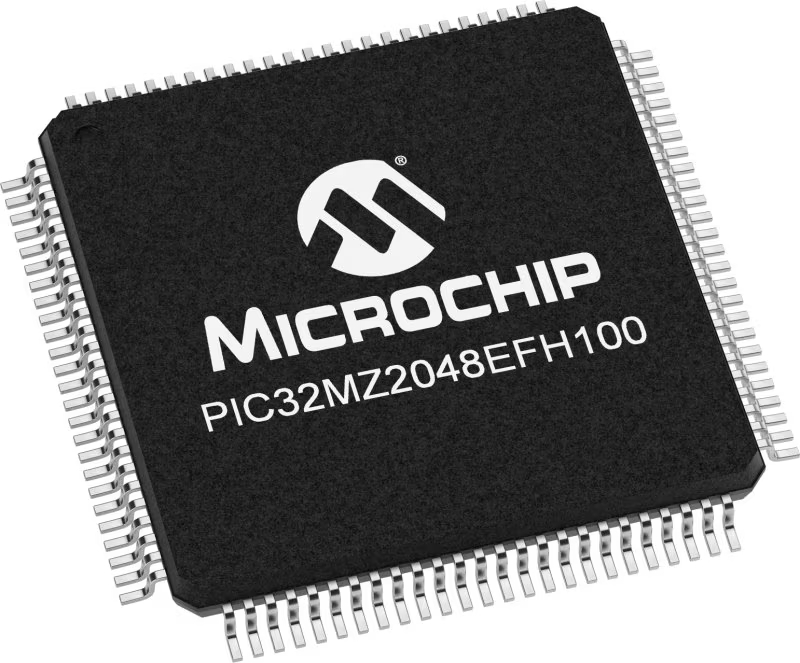
Architecture
PIC32
MCU Memory (KB)
2048
Silicon Vendor
Microchip
Pin count
100
RAM (Bytes)
524288
Used MCU Pins
mikroBUS™ mapper
Take a closer look
Click board™ Schematic
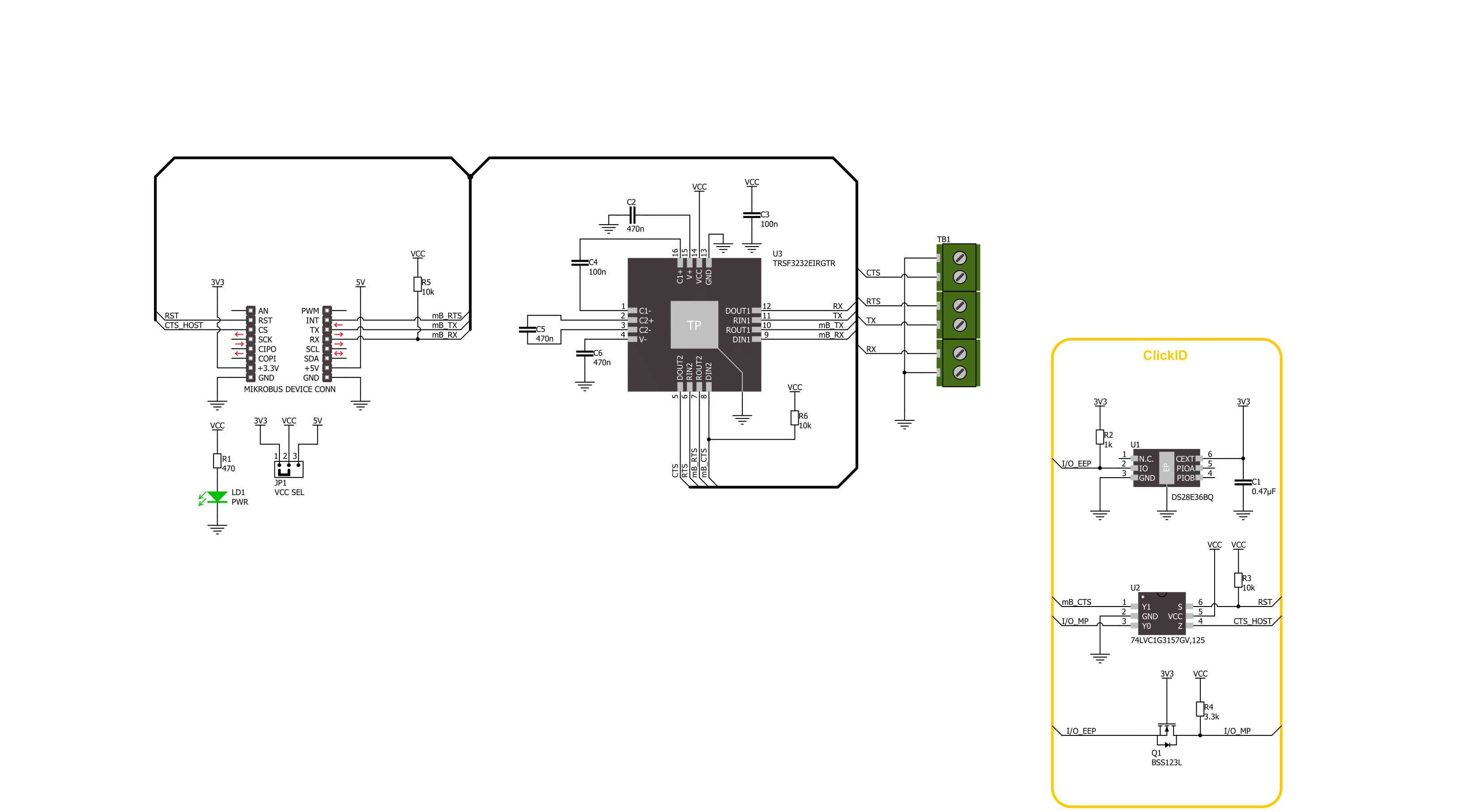
Step by step
Project assembly
Software Support
Library Description
RS232 4 Click demo application is developed using the NECTO Studio, ensuring compatibility with mikroSDK's open-source libraries and tools. Designed for plug-and-play implementation and testing, the demo is fully compatible with all development, starter, and mikromedia boards featuring a mikroBUS™ socket.
Example Description
This example demonstrates the use of an RS232 4 Click board by showing the communication between the two Click board configured as a receiver and transmitter.
Key functions:
rs2324_cfg_setup- This function initializes Click configuration structure to initial values.rs2324_init- This function initializes all necessary pins and peripherals used for this Click board.rs2324_generic_write- This function writes a desired number of data bytes by using UART serial interface.rs2324_generic_read- This function reads a desired number of data bytes by using UART serial interface.
Application Init
Initializes the driver and logger and displays the selected application mode.
Application Task
Depending on the selected mode, it reads all the received data or sends the desired message every 2 seconds.
Open Source
Code example
The complete application code and a ready-to-use project are available through the NECTO Studio Package Manager for direct installation in the NECTO Studio. The application code can also be found on the MIKROE GitHub account.
/*!
* @file main.c
* @brief RS232 4 Click Example.
*
* # Description
* This example demonstrates the use of an RS232 4 Click board by showing
* the communication between the two Click board configured as a receiver and transmitter.
*
* The demo application is composed of two sections :
*
* ## Application Init
* Initializes the driver and logger and displays the selected application mode.
*
* ## Application Task
* Depending on the selected mode, it reads all the received data or sends the desired
* message every 2 seconds.
*
* @author Stefan Filipovic
*
*/
#include "board.h"
#include "log.h"
#include "rs2324.h"
// Comment out the line below in order to switch the application mode to receiver
#define DEMO_APP_TRANSMITTER
#define DEMO_TEXT_MESSAGE "MIKROE - RS232 4 Click board\r\n"
static rs2324_t rs2324;
static log_t logger;
void application_init ( void )
{
log_cfg_t log_cfg; /**< Logger config object. */
rs2324_cfg_t rs2324_cfg; /**< Click config object. */
/**
* Logger initialization.
* Default baud rate: 115200
* Default log level: LOG_LEVEL_DEBUG
* @note If USB_UART_RX and USB_UART_TX
* are defined as HAL_PIN_NC, you will
* need to define them manually for log to work.
* See @b LOG_MAP_USB_UART macro definition for detailed explanation.
*/
LOG_MAP_USB_UART( log_cfg );
log_init( &logger, &log_cfg );
log_info( &logger, " Application Init " );
// Click initialization.
rs2324_cfg_setup( &rs2324_cfg );
RS2324_MAP_MIKROBUS( rs2324_cfg, MIKROBUS_1 );
if ( UART_ERROR == rs2324_init( &rs2324, &rs2324_cfg ) )
{
log_error( &logger, " Communication init." );
for ( ; ; );
}
#ifdef DEMO_APP_TRANSMITTER
log_printf( &logger, " Application Mode: Transmitter\r\n" );
#else
log_printf( &logger, " Application Mode: Receiver\r\n" );
#endif
log_info( &logger, " Application Task " );
}
void application_task ( void )
{
#ifdef DEMO_APP_TRANSMITTER
rs2324_generic_write( &rs2324, DEMO_TEXT_MESSAGE, strlen( DEMO_TEXT_MESSAGE ) );
log_printf( &logger, "%s", ( char * ) DEMO_TEXT_MESSAGE );
Delay_ms( 1000 );
Delay_ms( 1000 );
#else
uint8_t rx_data = 0;
if ( rs2324_generic_read( &rs2324, &rx_data, 1 ) > 0 )
{
log_printf( &logger, "%c", rx_data );
}
#endif
}
int main ( void )
{
/* Do not remove this line or clock might not be set correctly. */
#ifdef PREINIT_SUPPORTED
preinit();
#endif
application_init( );
for ( ; ; )
{
application_task( );
}
return 0;
}
// ------------------------------------------------------------------------ END
Additional Support
Resources
Category:RS232
